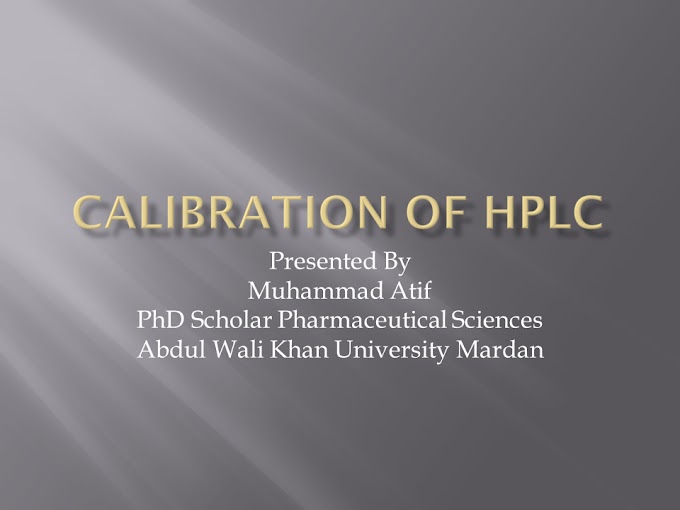Spectroscopy
— Spectroscopy
is derived from two words a Latin word specere which means “ to look at”
and a Greek word skopia means “ to see”
— The
study of the interaction between matter and electromagnetic radiation is known
as spectroscopy.
— The
study of the emission and absorption of light and other radiations by matter is
known as spectroscopy.
— Spectroscopy
were famous for visible spectrum traditionally, however UV, X-ray, and gamma
spectroscopy are also very applicable as an analytical tool.
— The
data obtained from spectroscopy is usually presented as spectrum.
— Spectroscopy
can involve any interaction between light and matter, including absorption,
emission, scattering, etc.
— When
a beam of electromagnetic radiation passes through a sample, the photons
interact with the sample.
— As a
result of the interaction of photons with the sample they are either absorbed,
reflected, refracted, etc.
— Absorbed
radiation affects the electrons and chemical bonds in a sample.
— In
some cases, the absorbed radiation leads to the emission of lower- energy
photons.
— Spectroscopy
reveals the effect of incident radiation upon the sample.
— Spectrum
obtained as a result of emission and absorption are used to collect information
about the sample material.
UV Visible Spectroscopy
— Analytical
technique that measures the amount of discrete wavelength of light in
UV-visible range that are absorbed by or transmitted through a sample in
comparison to a reference or blank sample.
— UV
range 100 to 400nm
— Deep
UV range 100 to 200nm
— Visible
range 400 to 700nm
Principal
— Molecules
containing bonding and non bonding electrons can absorb energy in the form of
UV or Visible light and gets excited to higher molecular orbitals.
— Working
of UV Visible spectroscopy is based on Beer-Lambert law which states that..
— When
a beam of monochromatic light is passed through a solution of an absorbing
substance,
— the
rate of decrease of intensity of radiation with thickness of the absorbing
solution is proportional to the incident radiation as well as the concentration
of the solution.
— The
expression of Beer-Lambert law is
— A = log (I0/I) = Ecl
— Where,
A = absorbance
— I0 =
intensity of light incident upon sample cell
— I =
intensity of light leaving sample cell
— C =
molar concentration of solute
— L = length of sample cell (cm.)
— E =
molar absorptivity
— More
the concentration of solution the higher will be the absorbance due to the
increased interaction of molecules.
— Similarly
longer the path length the more molecules will interact and hence more will be
the absorbance
Instrumentation
— Light
source
— Mostly
used light sources are tungsten filament lamps and Hydrogen-Deuterium lamps
— Monochromator
— It
is mostly consist of a prism and a slit and select particular wavelength of
light.
— Sample
and Reference Cell
— They
are made up of quarts and are called cuvetts
— Detector
— Photocells
working as detector and it measures the light transmitted from the sample
— Recording
Device
— A
computer system
Application
— It
is used in qualitative and quantitative determination of different analytes
such as metal ions, organic compounds and bilogical macro and micro molecules.
— Used
in polymer analysis.
— Determination
of functional groups.
— Organic
compounds structural elucidation
— Quantitative
determination of pharmaceutical substances.
— Identification
and quantitative determination of poly nuclear aromatic compounds.
— Determination
of impurities.
— As
HPLC detector
FTIR
Fourier Transform Infrared Spectroscopy
What is FTIR


Introduction
— FTIR
spectroscopy is an analytical technique, which is used for identification of
Organic, Polymeric, Inorganic compounds in Pharmaceutical industry,
Petrochemical engineering, And Food industries.
— FTIR
uses Infrared light to scan test sample
and observe chemical properties. It works on the fingerprint of molecules,
which is a great tool for us in chemical identification.
— This
tiny beautiful optical piece was invented by Albert Abraham Michelson, also
received NOBLE prize in 1907.
— The
range of infrared region is 12800 ~ 10 cm-1 near-infrared region
(12800 ~ 4000 cm-1), mid-infrared region (4000 ~ 200 cm-1)
and far-infrared region (50 ~ 1000 cm-1)
Instrumentation

— Input
— Mirror
1
— Mirror
2
— Beam
Splitter
— Output
(Detector)
How Ftir works
— Ftir
is based on the Michelson interferometer Experimental setup as shown in
previous slide
— The
interferometer consist of Source, beam splitter, fixed mirror, movable
mirror(translates back and forth very precisely), and output.
— The
beam splitter is made of special material which transmits half radiation and
reflects half radiation.
— The
radiation from the source strikes beam splitter which is divided into two
beams, one beam transmits to fixed mirror and 2nd beam reflects back
to beam splitter.
— Again
half radiation transmits and half reflects back to beam splitter.
— This
transmission and reflection results in one beam passes to output (detector) and
the other beam back to the source.
Principle of Ftir
— The
basic principle of Ftir is to identify the functional group by providing or
striking the material with some energy packets (in the form of IR
light/Radiation).
— The
functional group in a material attached with each other with specific bonds.
And these bonds will produce some stretching, wagging and vibrational movement
when struck by IR source.
— Now
when IR radiation passes through a molecule, some radiation will be absorbed
and some radiation passes through. The absorbed radiation is converted into
that movement ( Rotational,
Vibrational) by sample molecule, representing the molecular fingerprint
(Functional Group) of sample.
— The
resulting signal on detector produce a spectrum which is shown on our monitor
of computer attached to Ftir.
NMR
Nuclear Magnetic Resonance Spectroscopy
— Nuclear
magnetic resonance is the most powerful physicochemical tool to determine the
organic structures of molecules.
— NMR
Spectroscopy is the study of molecular structure determination by recording the
interaction of radiofrequency (Rf) electromagnetic radiations with the nuclei
of molecules placed in a strong magnetic field.
Basis of NMR
— NMR
is used in determination of molecular structures as well as the content and
purity os samples.
— The
most widely used method of NMR is Proton (1H) NMR in analytical chemistry.
— The protons present in the molecule will
behave differently depending on the surrounding chemical environment, making it
possible to elucidate their structure.
NMR Principal
— As
per the NMR principal most of the nuclei are exhibiting spin and all the nuclei
are charged electrically.
— A
nucleus with an odd atomic number or an odd mass number has a nuclear spin.
— The
spinning charged nucleus generates a magnetic field.
— When
placed in an external field these spinning protons act like bar magnets.
— When
an external magnetic field is applied energy transfer from base energy state to
higher energy state occur.
— The
magnetic fields of the spinning nuclei will align either with the external
field, or against the field.
— The
wavelength at which energy transfer occur coincide with the radio waves.
— Emission
of energy at the same frequency occur when the spin comes back to the base
state.
— Processing
of NMR spectrum for the concerned nuclei is measured by the signals that
matches this transfer.
— The
number of signals shows how many different kinds of protons are present.
— The
location of the signals shows how shielded or deshielded the proton is.
— The
intensity of the signal shows the number of protons of that type.
— Signal splitting shows the number of protons
on adjacent atoms.
Working of NMR
— 1st
of all sample is placed within magnetic field.
— The
nuclei sample is excited with the help of radio waves within the magnetic field
to generate NMR signals.
— A
detector sensitive to radio waves is used to detect these signals.
— The
intramolecular magnetic filed surrounding the molecules changes the resonance
frequency of the atoms in the molecule.
— These
changes in the resonance frequency of atom gives detain about the functional
groups and structure of the molecule.
— Reaction
state, structure of molecule, chemical environment and dynamics of a molecule
are determined in this way by applying this technique.
Chemical Shift
— A
nuclei that exhibit charge when do spinning it generates magnetic field, this
magnetic field results magnetic moment.
— This
magnetic moment is directly proportional to the spin.
— When
an external magnetic field is applied it results in two spin states
— Up
spin
— Down
spin
— Among
these up spin and down spin one aligns with the external magnetic filed and the
other one opposes it.
— Difference
between the resonant frequency of the spinning charged nuclei i.e proton and
the signals of the reference molecule characterize the chemical shift.
— Magnetic
shielding
— If
all protons absorbed the same amount of energy in a given magnetic field, not
much information could be obtained.
— But
protons are surrounded by electrons that shield them from the external field.
— Circulating
electrons create an induced magnetic field that opposes the external magnetic
field.
— Magnetic
field strength must be increased for a shielded proton to flip at the same
frequency.
— Nuclear
magnetic resonance chemical change is one of the most important
properties usable for molecular structure determination.
— 1H and 13C are the most widely used nuclei
that are detected by NMR
— Beside
the above, 15N (nitrogen 15), 19F (fluorine 19), are also used.
— Chemical
shift is measured in (ppm)parts per million.
— Chemical
shift δ = νsample
- ν reference
— ν reference
— V
sample = absoulte frequency of sample
— V
reference = absoulte frequency reference
— Magnetic
field B0 would be same for both reference and sample
— numerator
is usually expressed in hertz
— and the denominator in megahertz
— Chemical
Shift δ is expressed in ppm
— The
detected frequencies (in Hz) for 1H, 13C,
and 29Si nuclei are usually referenced against TMS
(tetramethylsilane), TSP (Trimethylsilylpropanoic acid), or DSS (Sodium
trimethylsilylpropanesulfonate).
— TMS,
TSP and DSS have a chemical shift of zero if chosen as the reference.
— NMR
signal observed at a frequency 300 Hz higher than the signal from TMS,
where the TMS resonance frequency is 300 MHz, has a chemical shift of:
—
— δ = 300Hz =
1 x 10-6 = 1ppm
— 300 x 106
Instrumentation
— Sample
holder: Sample holder is 8.5 cm long and 0.3 cm in diameter glass tube.
— Magnetic
coils : Magnetic coil generates magnetic field whenever current flows
through it.
— Permanent
magnet : Permanent magnet provides a homogenous magnetic field at 60 –
100 MHZ.
— Sweep
generator: It modifies the strength of the magnetic field which is
already applied.
— Radiofrequency
transmitter: It generates a powerful and short pulse of the radio
waves.
— Radiofrequency: It
supports detecting receiver radio frequencies.
— RF
detector: It determines unabsorbed radio frequencies.
— Recorder: It
records the NMR signals which are received by the RF detector.
— Readout
system: Computer system records the data.
Applications
— NMR
is used in the structural determination of organic and inorganic compounds.
— Microstructure
determination of polymer chain.
— Determination
of physical and chemical properties of atoms.
— In
medicine it is used in MRI, Tumors, tissue perfusion studies and angiography.
Presented
By
Muhammad
Atif
PhD
Scholar Pharmaceutical Sciences AWKUM
Manager
QA Decent Pharma Islamabad Pakistan.






0 Comments